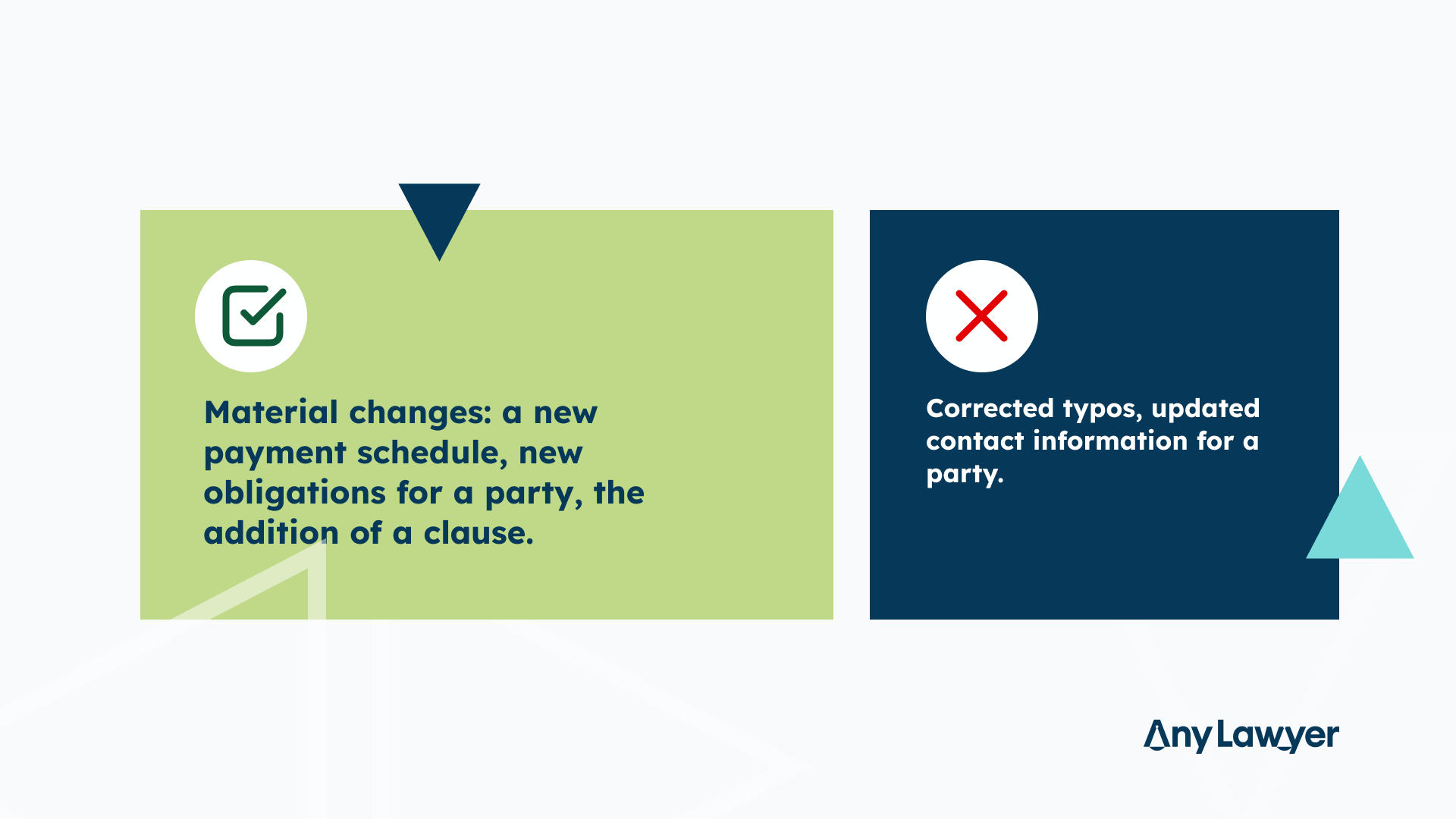Contract amendments are a common but often complex part of the business world. They can be used to add, remove, or modify terms in an existing contract and are necessary to keep agreements up-to-date and accurate. In this article, we will explain what a contract amendment is, why it is important, discuss the different types of amendments, answer frequently asked questions about amending contracts, and provide a practical guide for when and how to amend them. We will also explore the benefits of using AI tools for amending contracts.
The purpose of a contract
Contracts are written and signed to regulate the relationship between two or more parties, ensuring that they fulfill their respective responsibilities and benefit from the stated terms. However, circumstances change, due to factors such as new regulations, different business opportunities, shifting speed of business growth, etc. When the promises made in a contract need to change to fit the new situation, an amendment becomes necessary.
What are contract amendments?
A contract amendment is exactly what it sounds like - a written agreement in the form of an addition or alteration to an existing contract. An amendment is a separate document that impacts original contract terms, and as such needs to be analyzed together with the original terms.
This can be done for any number of reasons, such as changing contact information, adding new terms and conditions, updating the payment schedule, or amending the duration of the contract. Amendments are important because they ensure that both parties to a contract are up to date on all relevant obligations and rights under the agreement, as well as changes in circumstances (such as with contact information).
Importantly, amendments must be mutually agreed upon by all parties to a contract. Whether the amendment adds, deletes or changes parts of the original document, it must be signed by all parties to be binding. It is also important to remember that the initial contract remains in place, with specific changes added by the amendment.
When to amend a contract?
Contract amendments are used in a variety of scenarios, such as when parties to a contract wish to:
- Update the contact information of one or more signatories
- Change the payment terms
- Add additional terms and conditions
- Extend the duration of the agreement
- Make changes to how conflicts will be resolved.
In other words, any time a party wants to make changes to the contractual terms, all parties can discuss amending the contract. Sometimes, the amendment simply formalizes an existing informal agreement that arose due to one or multiple parties being unable to fulfill all terms of their agreement.
For example, if a deadline turns out to be too short, and both parties to the contract decide to be understanding about it, they can carry on without invoking contractual obligations that would normally result from the delay. In such a situation, it is often worth it to put this informal agreement into writing.
However, the best time to update an agreement is before any changes in circumstance occur. This is important because it ensures that both parties are up to date on all relevant obligations and rights under the agreement.
How to amend a contract
Amending a contract requires careful consideration of the proposed amendment, discussion with the other party, and detailed legal drafting. Often, business contracts include clauses that specify how and when the agreement can be amended.
The most common ways to amend a contract include:
- A contract amendment letter: This is a written document that outlines the agreed-upon changes to the contract. It must be signed by all parties to be binding.
- A contract amendment form or template: This is a standard form outlining any changes that have been made and needs to be countersigned by all parties to properly execute it.
- An oral agreement: In some cases, parties may agree that changes to the contract are necessary and make a verbal agreement. However, this type of amendment is difficult to enforce if it is not in writing.
Common types of contract amendments
There are several common types of amendments that you should be aware of when considering amending a contract.
Material changes
These types of amendments are generally made to revise existing terms and conditions within an agreement, such as changing the payment schedule or adding new obligations for one of the parties.

Non-material changes
These are typically minor changes that do not alter the original intent or substance of the contract, such as correcting typos or updating contact information.
Examples of contract amendments
Here are some examples of typical contract amendments:
- Adding a new term to the contract, such as a “no-refund” clause.
- Replacing an existing clause.
- Changing the payment schedule, such as changing from monthly payments to quarterly payments.
- Altering the duration of the contract, such as extending it by six months.
- Changing the price or fee for a service or product.
- Altering the liabilities of parties.
Best practices for amending contracts
When amending a contract, it is important to keep the following best practices in mind:
- Make sure all parties are aware of the potential changes and agree with them before signing any amendment documents.
- Ensure that any changes are clearly specified and accurately reflected in the amended contract.
- Carefully draft and review the amendment to guarantee that it is in accordance with the laws of your jurisdiction.
- To avoid future disputes, document any verbal amendments in writing and make sure all parties sign off on them.
- Make sure the amendment is properly dated.
- Add a reference to the title of the existing agreement in the amended version. Do the same for the original parties named and signing date.
- Store the original contract and the amendment together, so neither will be easy to overlook.
- Try to only amend a contract once, if possible. Should further amendment be necessary - particularly if it is meant to change previous amendments - writing a new contract is often less confusing.
- When changing a specific section of the existing agreement, restate it in its entirety, with the changes. Simply describing the changes can lead to inconsistent or unclear language, and even loopholes.
- Make it clear that the changes only apply to specific sections referred to in the amendment, and that other parts of the contract stay the same.
- Make sure that everyone who signed the original contracts signs and dates the amendment.
Frequently asked questions about contract amendments
Q: How do I go about amending a contract?
A: First, you need to identify what needs to be changed or added. You should then contact the other party and discuss the proposed amendment. If both parties agree on the changes, you will need to write up an amendment form and have it signed by both parties before it is legally binding.
Q: Can an amendment change an entire section of the initial contract?
A: Yes, an amendment can change or replace an entire section of the initial contract.
Q: Can I add terms when I amend an agreement?
A: Yes, you can add terms when amending an agreement. However, both parties must agree on these new terms and sign the amendment.
Q: Does an amendment replace the original contract?
A: No, an amendment does not replace the original contract. It simply modifies it in some way by altering or adding specific terms.
Q: When is it necessary to amend an existing contract?
A: Amendments are usually necessary when there are changes in circumstances, such as contact information or payment schedule. It is also important to update contracts regularly to ensure they remain legally-binding and enforceable.
Q: What is the difference between a contract addendum and a contract amendment?
A: An amendment is a change to an existing contract, while an addendum is a new section that is added to the original agreement. Both can have varying levels of specificity and are legally binding if they are signed by both parties. Contract addendums are commonly used to clarify certain sections or add new information, while contract amendments are used to alter the existing terms in a contract.
Q: What is a contract appendix?
A: A contract appendix is an addendum that includes additional information about the contract, such as a list of definitions or forms. It does not change any existing terms of the contract, but can be referenced when needed.
Q: What is contract variation?
A: A contract variation is the same thing as an amendment - a change to an existing contract that is agreed upon by both parties in order to either expand the scope of the agreement or modify one or more of its terms.
Q: What is supplemental agreement?
A: A supplemental agreement is a separate contract that complements an existing contract. It usually contains additional terms and conditions, but does not replace the original contract.
Q: Are oral contracts and amendments legally enforceable?
A: Oral contracts are generally enforceable as long as there is evidence of the agreement, such as emails or text messages. However, oral amendments to a contract may not be legally binding. It is best to document any changes in writing and have it signed by all parties involved.
Q: Do all the other parties need to sign the amendment?
A: All parties need to agree to the amendment in order for it to be legally binding. However, this does not need to take the form of a signature on a printed amendment. Parties can also use e-signatures or simply express their acceptance of the new terms in an email.
Q: What happens if only one party signs the amendment?
A: If only one party signs the amendment, it is not legally binding. To legally amend a contract, both parties must agree to the changes.
Q: Are there AI tools available for amending contracts?
A: Yes, there are AI tools available to help streamline the process of amending contracts. These tools can automate the contract review process and provide useful insights into clauses that may need to be changed or updated.
Q: Is contract law complicated?
A: Yes, contract law can be complex and requires an in-depth understanding of the legal requirements. It is best to consult with a lawyer if there is any question about amending or creating a contract.
Using AI tools for amending contracts
AI tools are a great way to simplify and streamline the contract amendment process. AI-based contract amendment software can automate the tedious drafting process, alter clauses based on prompts, and track agreement changes in real time. This makes it easier for both parties to keep up with the current status of their agreements.
Tools like AnyLawyer are also great for making sure the contract's terms are in line with current regulations. AnyLawyer's Ask feature offers near-instant fact-checking, and the tool's ability to flag potentially risky or unclear language ensures that all amendments are compliant with the law.
AI-based tools can also improve efficiency and facilitate collaboration among parties, by providing an easy way to share and compare drafts of contracts. This can significantly reduce the time it takes to reach agreement - something that is especially important when complex contracts are involved.
Benefits of using AI tools for crafting an amendment to a contract
Using AI-based software to amend contracts can help save time, money and resources. It also ensures that all changes are legally binding, making it easy to track agreements over their lifespan. Additionally, by automating the drafting process, it eliminates potential human errors and reduces the risk of legal disputes or confusion.
Improved accuracy and compliance
Automated contract amendment software can ensure that all amendments adhere to the law, reducing the risk of litigation.
Increased efficiency and reduced turnaround time
AI-based tools streamline the contract amendment process and reduce the time it takes to reach agreement.
Increased collaboration
AI-based tools make it easy for all parties to share and compare drafts of contracts, thereby facilitating collaboration among all stakeholders.
Cost savings
Automated contract amendment software can save businesses time and money by eliminating human error, reducing paperwork, and eliminating the need for manual reviews.
Improved visibility
AI-based tools can provide an easy way to keep track of contract amendments over their lifespan.
Dealing with contract amendments the smart way
Amending a contract can be complicated, but with the right tools it does not have to be. By using AI-based software to automate the process of amending contracts, business leaders and legal experts can make sure that their contracts stay up to date and are legally binding.




